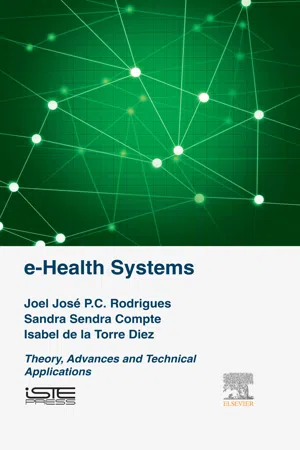
e-Health Systems
Theory and Technical Applications
- 296 pages
- English
- ePUB (mobile friendly)
- Available on iOS & Android
e-Health Systems
Theory and Technical Applications
About this book
e-Health Systems: Theory, Advances and Technical Applications offers a global vision of all the parties involved with e-health system deployment and its operation process, presenting the state of the art in major trends for improving healthcare quality and efficiency of healthcare management.The authors focus on ICT technologies and solutions for health management and healthcare applications, specifically emerging ICT to help reduce costs and improve healthcare quality, and healthcare trends in consumer empowerment and information-rich "Smart Care", with ubiquitous care access from anywhere, at any time, by any authorized person(s) when needed.Split into two parts, this book provides a comprehensive introduction to the concepts of e-health and delves into the processes carried out to store information, as well as the standards that are used; the authors explore applications and implementation of e-health systems, explaining in depth the types of wireless networks and security protocols employed to convert these systems into robust solutions avoiding any kind of data corruption and vulnerabilities.- Presents e-Health from implementation at the physical level, to the communication level between different systems and sensors- Considers all process security methods and the most relevant related standards- Suitable for students, academics, researchers, and professionals involved in applications to improve health management and eHealth systems
Frequently asked questions
- Essential is ideal for learners and professionals who enjoy exploring a wide range of subjects. Access the Essential Library with 800,000+ trusted titles and best-sellers across business, personal growth, and the humanities. Includes unlimited reading time and Standard Read Aloud voice.
- Complete: Perfect for advanced learners and researchers needing full, unrestricted access. Unlock 1.4M+ books across hundreds of subjects, including academic and specialized titles. The Complete Plan also includes advanced features like Premium Read Aloud and Research Assistant.
Please note we cannot support devices running on iOS 13 and Android 7 or earlier. Learn more about using the app.
Information
Electronic Medical Records and Their Standards
Abstract
keywords
1.1 Introduction
Table of contents
- Cover image
- Title page
- Table of Contents
- Copyright
- Preface
- Introduction
- Part 1: Electronic Health Records: Standards and Other Initiatives
- Part 2: Emerging e-Health Technologies and Applications
- Bibliography
- Index